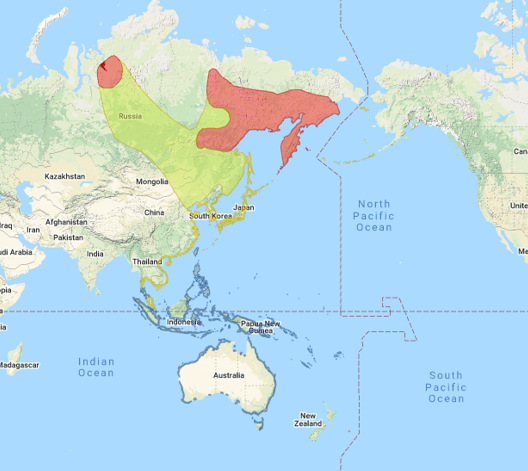Birdfinding.info ⇒ Locally common on its core wintering grounds, including many sites along the eastern and western coasts of Australia, and during spring and fall migration periods in eastern China, Taiwan, Korea, and Japan. In North America, it rare but regular in May, August, and September along Alaska’s Bering Sea coasts.
Gray-tailed Tattler
Tringa brevipes
Breeds in Siberia. Winters from Southeast Asia to western Polynesia.
Breeding. Breeds from late May to July in the taiga zone of Siberia and northern Mongolia, mainly in mountainous areas, west to the Yenisei River Valley, east to Chukotka, and south to Kamchatka. Nests in rocky creekbeds and similar terrain, usually in partly wooded areas, where it readily perches in trees.
Nonbreeding. Winters mainly on beaches and mudflats of the Philippines, central and eastern Indonesia, Micronesia, New Guinea, the Solomon Islands, and Australia.
Small numbers regularly winter north to Taiwan, southern Japan (Ryukyu Islands), west to the Malay Peninsula and Sumatra, south to Tasmania and New Zealand (both North and South Islands), and east to Tuvalu and Fiji.
Movements. Northbound migration apparently begins in late March or early April, with arrivals on the breeding grounds mostly in late May.
Southbound migration begins in August, when the majority depart the breeding grounds. Some adults leave earlier and some juveniles linger later. Arrivals on wintering grounds occur mainly in late September and October.
Regularly strays in spring and fall to the Aleutians, Pribilofs, St. Lawrence Island, and elsewhere along the Bering and Chukchi coasts of Alaska, north to Point Barrow. There are several fall and winter records from Hawaii (from Midway to the Big Island), and a handful from central Polynesia.
Exceptional vagrants have occurred far outside its normal range, including the Azores, Scotland, Seychelles, British Columbia, Washington, California, Maine, and Massachusetts.
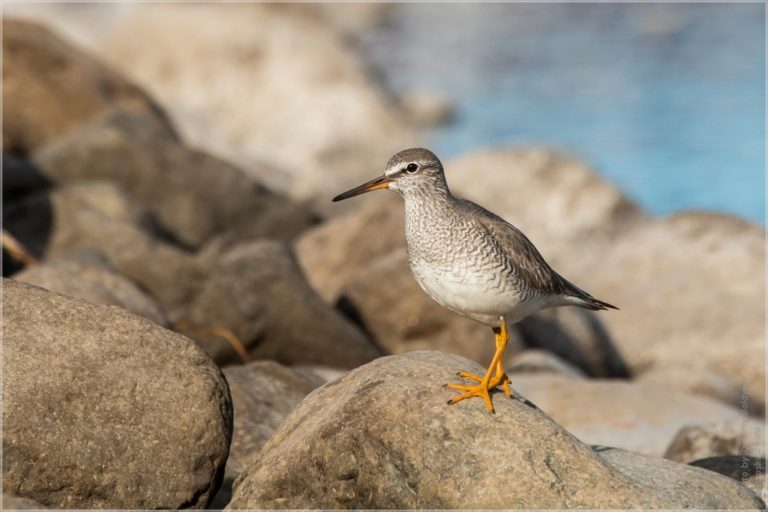
Gray-tailed Tattler, on breeding territory. (Dudinka Gorsovet, Siberia, Russia; June 8, 2017.) © Dmitry
Identification
A stocky, mid-sized, mostly gray sandpiper with short yellow legs and a straight bill. Habitually teeters and bobs like an Actitis sandpiper.
Very similar to the closely related Wandering Tattler, and can be nearly identical, but somewhat paler and slightly smaller (for a detailed comparison, see below).
In all adult plumages, the upperparts appear uniformly pale-to-medium-gray.
Has a thick, blackish lore-stripe and a whitish eyebrow. Compared to Wandering, Gray-tailed’s eyebrows tend to be more extensive—usually meeting on the forehead and extending behind the eye.
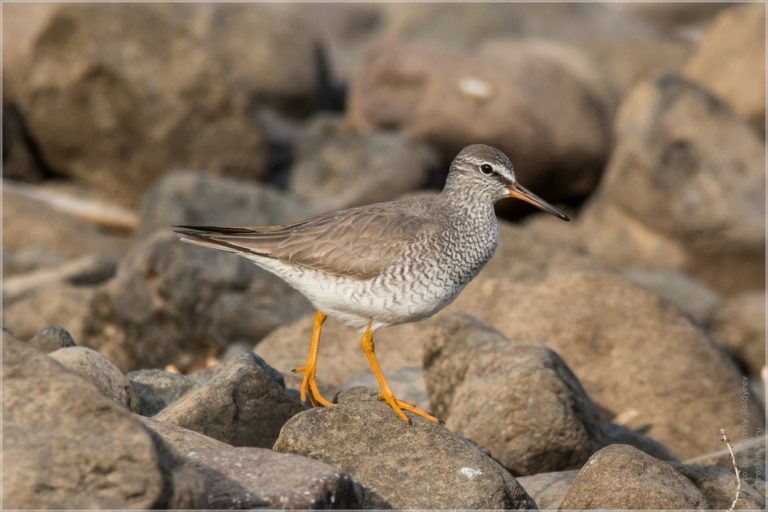
Gray-tailed Tattler, breeding plumage. (Dudinka Gorsovet, Siberia, Russia; June 8, 2017.) © Dmitry

Gray-tailed Tattler, breeding plumage. (Bukhta Narva, Primorskiy Kray, Russia; May 21, 2019.) © Pavel Parkhaev
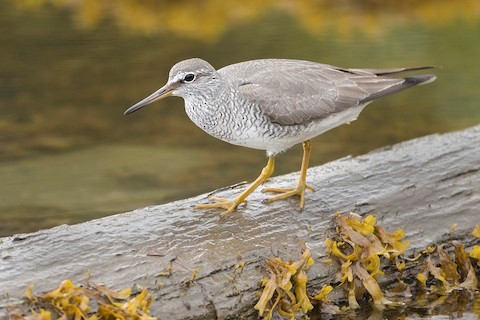
Gray-tailed Tattler, breeding plumage. (Minette Bay, Kitimat, British Columbia; June 26, 2020.) © Jeff Dyck
Breeding adults have a wavy pattern of gray and white chevrons on the chest, sides, and flanks. The markings are densest on the chest and sides, and become sparser on the mid-breast and flanks. The lower breast and belly usually remain all-white, often with a few widely-spaced bars on the undertail coverts.

Gray-tailed Tattler, breeding plumage. (Bukhta Narva, Primorskiy Kray, Russia; May 21, 2019.) © Pavel Parkhaev

Gray-tailed Tattler, breeding plumage. (Kawasaki, Kanagawa, Honshu, Japan; May 23, 2018.) Anonymous eBirder
The crown is mostly solid-gray, but the face and neck are finely streaked with white. Fine white streaks sometimes extend up into the forecrown.

Gray-tailed Tattler, breeding plumage. (Hong Kong; April 27, 2019.) © chan_siu_yuen
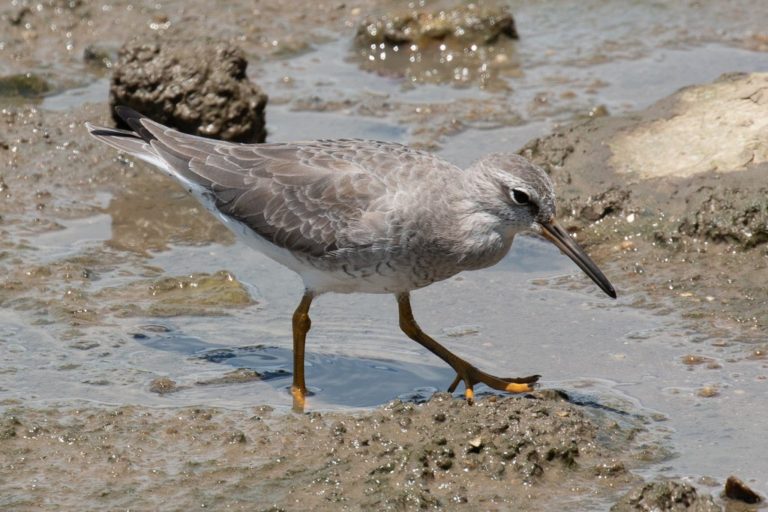
Gray-tailed Tattler, molting into breeding plumage. (Cairns, Queensland, Australia; March 21, 2017.) © Mark Ayers
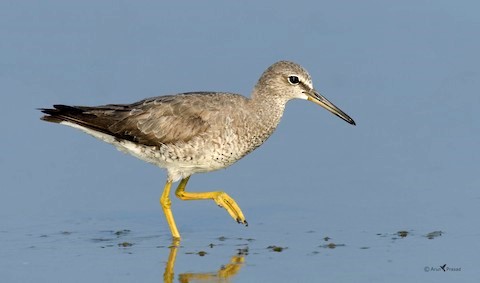
Gray-tailed Tattler, molting out of breeding plumage. (Pulicat Lake, Tamil Nadu, India; October 24, 2017.) © Arun Prasad
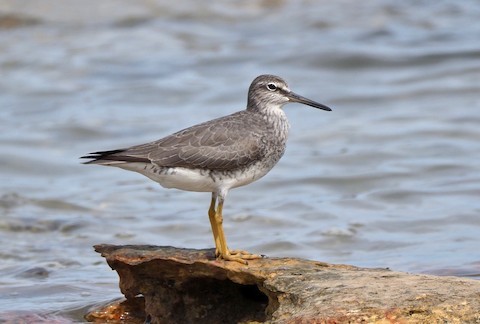
Gray-tailed Tattler, molting into breeding plumage. (Nightcliff, Darwin, Northern Territory, Australia; March 15, 2019.) © Ken Glasson

Gray-tailed Tattler, breeding plumage. (Minette Bay, Kitimat, British Columbia; June 26, 2020.) © David M. Bell

Gray-tailed Tattler, breeding plumage—but with unusually thin, indistinct eyebrow. (Gangwon-do, South Korea; May 5, 2020.) © Jay
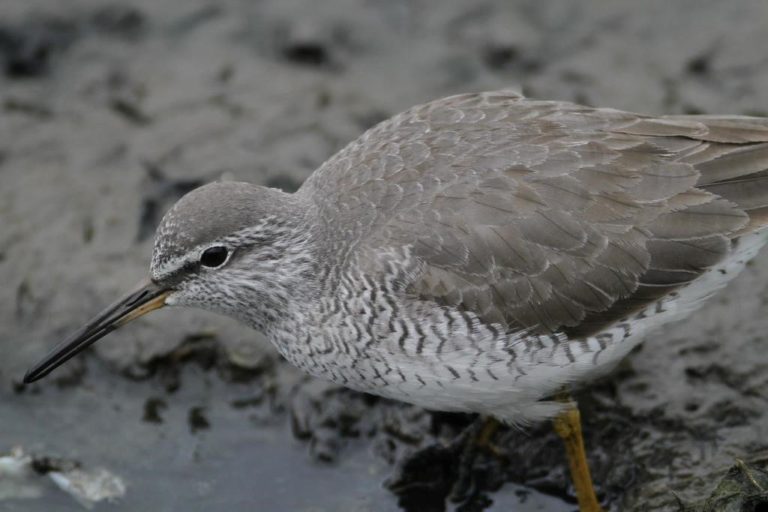
Gray-tailed Tattler, breeding plumage. (Taoyuan, Taiwan; May 2, 2013.) © 洪廷維

Gray-tailed Tattler, breeding plumage, with unusually extensive barring on the underparts. (South Ballina Beach, New South Wales, Australia; March 19, 2017.) © Steven McBride
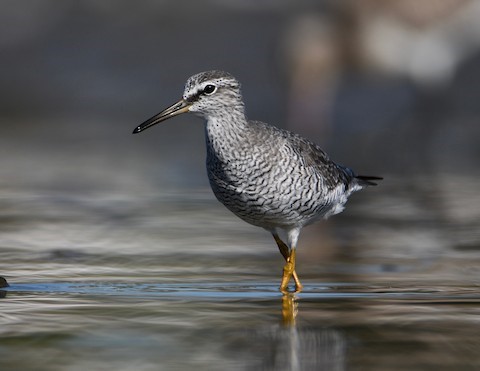
Gray-tailed Tattler, breeding plumage. (Queens Esplanade, Thorneside, Redland, Queensland, Australia; April 3, 2020.) © Michael Daley

Gray-tailed Tattler, breeding plumage. (Broome, Western Australia; May 12, 2016.) © Nigel Jackett
Nonbreeding adults are nondescript, with plain-gray upperparts and unmarked gray-and-white underparts. The chest and flanks are pale-gray and the lower breast, belly, and throat are white.

Gray-tailed Tattler, nonbreeding plumage. (Jacobs Well, Queensland, Australia; September 16, 2017.) © Stephen Haase
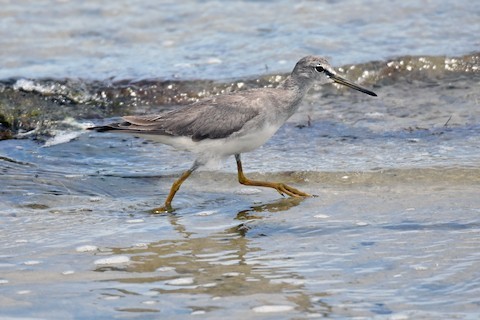
Gray-tailed Tattler, nonbreeding plumage. (Nairns, Mandurah, Western Australia; November 29, 2017.) © Geoffrey Groom
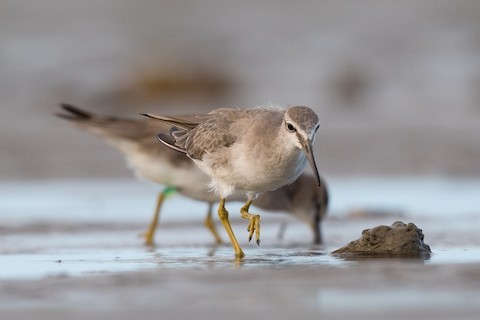
Gray-tailed Tattler, nonbreeding plumage, showing broad eyebrows that meet on the forehead. (Queens Esplanade, Thorneside, Queensland, Australia; December 19, 2020.) © Terence Alexander

Gray-tailed Tattler, nonbreeding plumage, showing broad white eyebrows that are partly divided on the forehead. (Queens Esplanade, Thorneside, Queensland, Australia; November 30, 2019.) © Hayley Alexander
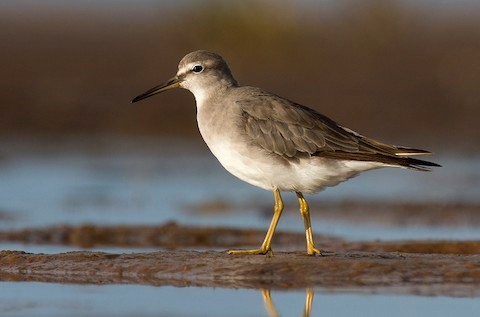
Gray-tailed Tattler, nonbreeding plumage. (Carnarvon, Western Australia; November 7, 2015.) © Leslie George

Gray-tailed Tattler, nonbreeding plumage. (Queens Esplanade, Thorneside, Queensland, Australia; November 30, 2019.) © Hayley Alexander
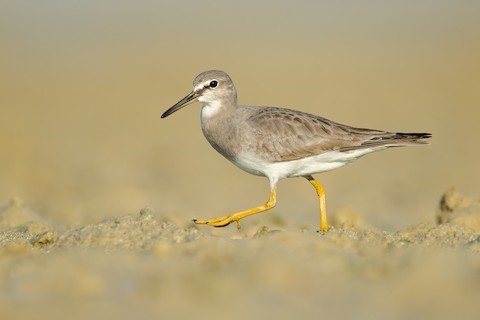
Gray-tailed Tattler, nonbreeding plumage. (Laem Pakarang, Phangnga, Thailand; December 29, 2019.) © Dorian Anderson
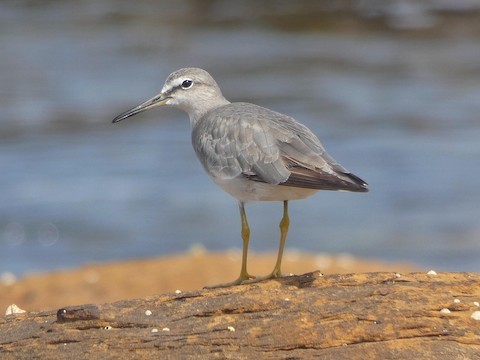
Gray-tailed Tattler, nonbreeding plumage. (Long Reef Aquatic Reserve, Collaroy, New South Wales, Australia; December 13, 2020.) © Levi Brown
Juveniles resemble nonbreeding adults, but they have a “toothed” pattern on the feather edges of their upperparts: dotted lines that consist of whitish spots separated by dark spots.

Gray-tailed Tattler, juvenile. (Gambell, St. Lawrence Island, Alaska; September 3, 2019.) © Tammy McQuade
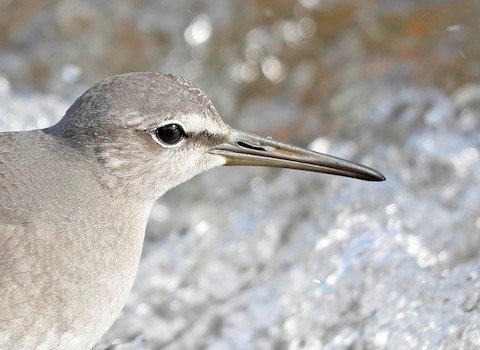
Gray-tailed Tattler, juvenile, close-up showing nasal groove ending near the mid-point of the bill. (Gambell, St. Lawrence Island, Alaska; September 3, 2019.) © Tammy McQuade
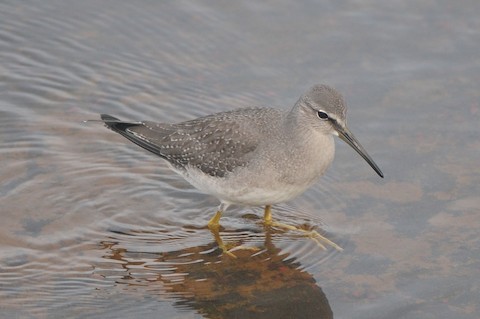
Gray-tailed Tattler, juvenile. (St. Paul Island, Alaska; August 24, 2015.) © Cory Gregory
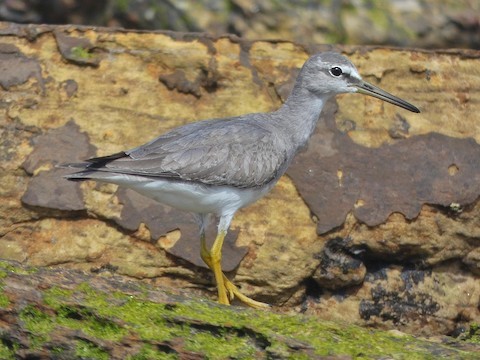
Gray-tailed Tattler, juvenile. (Long Reef Aquatic Reserve, Collaroy, New South Wales, Australia; December 13, 2020.) © Levi Brown

Gray-tailed Tattler, juvenile. (Taipei, Taiwan; September 30, 2017.) © David Irving

Gray-tailed Tattler, juvenile. (Queens Esplanade, Thorneside, Queensland, Australia; October 3, 2019.) © Michael Daley

Gray-tailed Tattler, juvenile. (Queens Esplanade, Thorneside, Queensland, Australia; December 19, 2020.) © Hayley Alexander
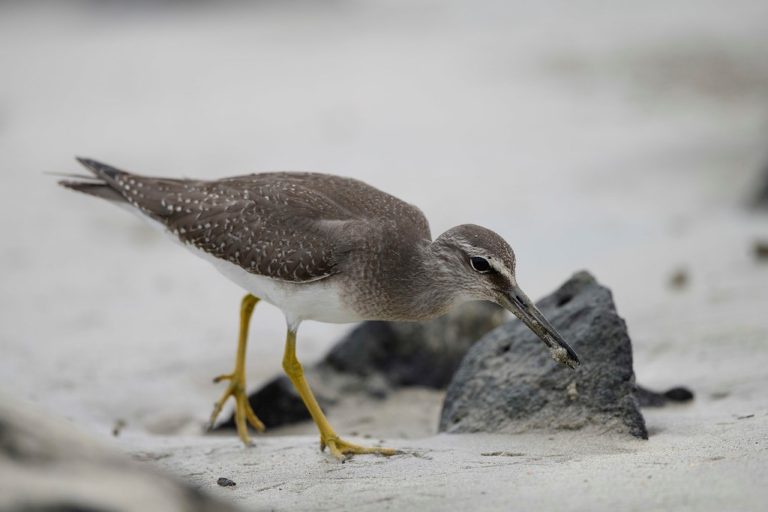
Gray-tailed Tattler, juvenile, appearing unusually dark for a Gray-tailed, but showing prominent toothed or dotted-line pattern on upperparts and bold eyebrow. (Taiwan; October 11, 2020.) © Sin Syue Li
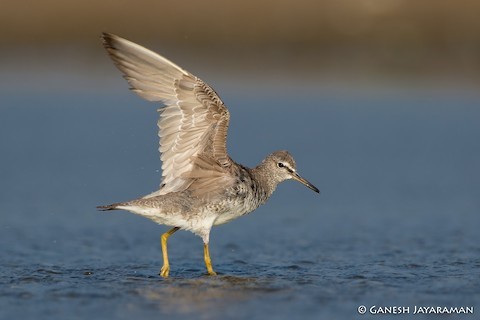
Gray-tailed Tattler, molting out of breeding plumage. (Pulicat Lake, Tamil Nadu, India; October 20, 2017.) © Ganesh Jayaraman
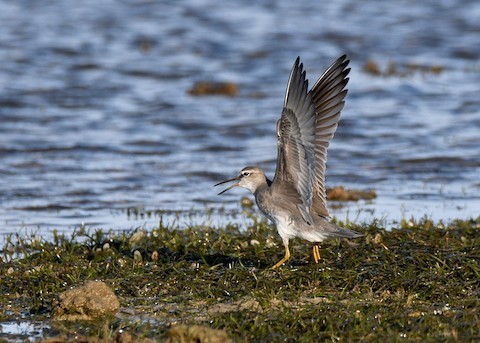
Gray-tailed Tattler, nonbreeding plumage. (Wellington Point, Queensland, Australia; March 12, 2021.) © Michael Daley

Gray-tailed Tattler, juvenile. (Queens Esplanade, Thorneside, Queensland, Australia; January 26, 2018.) © Terence Alexander

Gray-tailed Tattler, nonbreeding plumage. (Wellington Point, Queensland, Australia; February 23, 2019.) © Matt Wright – Faunagraphic Wildlife Tours

Gray-tailed Tattler, juvenile. (Buffalo Creek, Northern Territory, Australia; October 6, 2019.) © Caleb Putnam

Gray-tailed Tattler, nonbreeding plumage. (Nairns, Mandurah, Western Australia; November 29, 2017.) © Geoffrey Groom
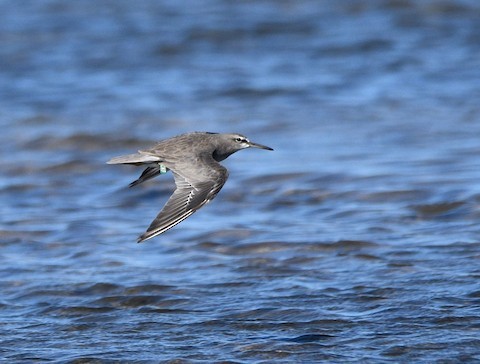
Gray-tailed Tattler, nonbreeding plumage. (Wellington Point, Queensland, Australia; January 14, 2021.) © Michael Daley
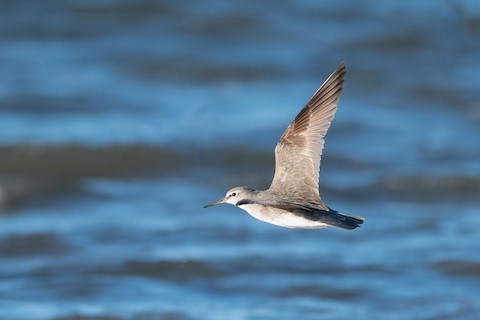
Gray-tailed Tattler, nonbreeding plumage. (Beth Boyd Park, Thorneside, Redland, Queensland, Australia; August 24, 2020.) © Hayley Alexander
Cf. Wandering Tattler. Wandering and Gray-tailed Tattlers are nearly identical sibling species which occur together regularly across much of the western and central Pacific from Beringia south through Micronesia and Melanesia to Australia and New Zealand. Wandering is darker overall and more heavily marked in breeding plumage, but there is a broad zone of overlap in which many individuals, especially nonbreeding adults, are ambiguous—nondescript, plain-gray sandpipers (see comparison below).

Gray-tailed Tattler, nonbreeding plumage. (Carnarvon, Western Australia; November 7, 2015.) © Leslie George
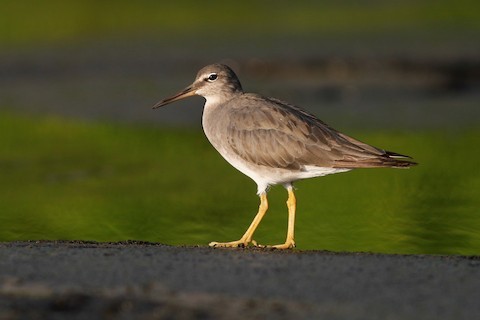
Wandering Tattler, nonbreeding plumage. (Aimakapa Pond, Kaloko-Honokohau National Historic Park, Big Island, Hawaii; October 26, 2019.) © John Sullivan
Fortunately, breeding adults and juveniles are somewhat more distinctive.

Gray-tailed Tattler, breeding plumage. (Kawasaki, Kanagawa, Honshu, Japan; May 23, 2018.) Anonymous eBirder
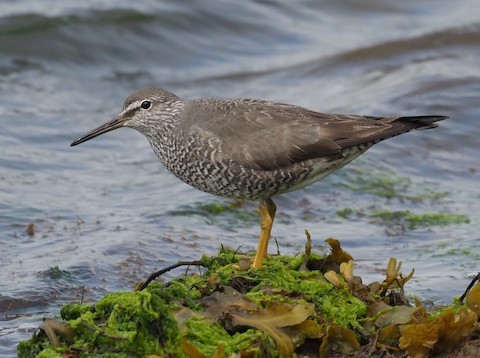
Wandering Tattler, breeding plumage. (St. Paul Island, Alaska; July 28, 2019.) © Stephan Lorenz
Depending on the circumstances of an observation, potentially useful distinctions include: voice; habitat; general coloration; facial markings; barring on the underparts; and typical juvenile plumages. Despite the name, tail color is rarely a useful clue.
Voice: Vocalizations are the most reliable means of identifying an ambiguous tattler, though they are more variable and can be more similar than most references imply.
Wandering’s common calls are trills or slower series of high-pitched notes—usually monotone or in a narrow range. However, on the breeding grounds, Wandering’s trills are more variable, less monotone, sometimes structured in distinct phrases, which it may repeat rhythmically.
Gray-tailed has two common call types: trills and upslurred, two-syllable whistles (tuu-WEET!). Its trills can resemble Wandering’s, but are usually more fluid and variable in pitch. Gray-tailed sometimes blends these call-types, repeating its typical whistle as a trill.
Habitat: The tattlers have somewhat different preferences. Wandering prefers rocky shores and reefs, whereas Gray-tailed prefers mudflats and sandy beaches. Habitat is not a reliable indicator—as each occurs in the other’s favored settings—but it can be a helpful clue.
General Coloration: Both tattlers are predominantly gray, but they differ in shade. Wandering averages darker, roughly medium-gray, whereas Gray-tailed usually seems pale-gray, sometimes appearing bleached. These are subjective impressions, and rarely definitive, but helpful as a first impression and in combination with other factors.

Gray-tailed Tattler, a nonbreeding-plumaged individual with brows that clearly meet on the forehead, as is typical of Gray-tailed. (Queens Esplanade, Thorneside, Queensland, Australia; December 19, 2020.) © Terence Alexander
Facial Markings: Across all plumages, the most consistent visual difference between that tattlers is that Gray-tailed’s eyebrow is consistently longer and wider than Wandering’s. This is not an absolute distinction, but it is a strong tendency, despite the variation within each species which leads to some overlap and a few ambiguous individuals.
Some references indicate that Gray-tailed’s brows always meet on the forehead, whereas Wandering always has at least a thin gray divider on its forehead. In general, Gray-tailed has much more white on its forehead (sometimes extending onto the forecrown in streaks) and its brow tends to be much wider than Wandering’s. But both species vary: some Wandering have relatively bold brows which can meet (or nearly meet) on the forehead, and some Gray-tailed have atypically short, indistinct brows that appear to be divided on the forehead.

Wandering Tattler, juvenile showing dark forehead and divided brows typical of Wandering. (Flat Rock, Ballina, New South Wales, Australia; October 5, 2019.) © Steven McBride
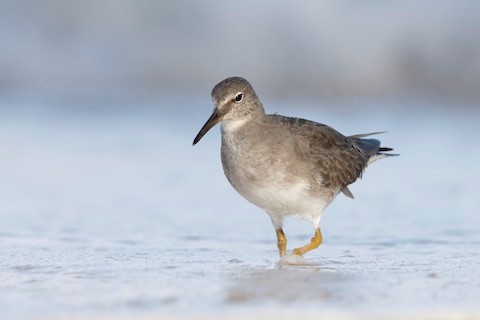
Wandering Tattler, a nonbreeding-plumaged individual with wide brows that appear to meet—or nearly so—on the forehead, thus resembling Gray-tailed Tattler. (Malaekahana State Recreation Area, Oahu, Hawaii; January 26, 2019.) © Sharif Uddin

Gray-tailed Tattler, a nonbreeding-plumaged individual with brows that appear divided—or nearly so—on the forehead, thus resembling Wandering Tattler. (Queens Esplanade, Thorneside, Queensland, Australia; November 30, 2019.) © Hayley Alexander
Barring on the Underparts in Breeding Plumage: Breeding adults are identifiable by the density and extent of gray bars or chevrons on the underparts. On Wandering in peak breeding plumage, the gray bars are thicker, denser, and more extensive compared to Gray-tailed, which has relatively narrow and sparse markings.
In particular, Gray-tailed is essentially all-white on the lower breast and belly, and has at most a few isolated bars on the undertail coverts, whereas Wandering in breeding plumage has several bold bars on the undertail.
However, adult tattlers spend much of the year in between peak breeding plumage and typical nonbreeding plumage. In their intermediate stages the two species overlap, so a lightly-marked Wandering can look much like a Gray-tailed—which means, in effect, that all Gray-tailed look like a lightly-marked Wandering. Some differences in pattern may be consistent, but they are difficult to generalize.

Gray-tailed Tattler, breeding plumage, showing mostly unmarked flanks, as is typical of Gray-tailed. (Bukhta Narva, Primorskiy Kray, Russia; May 21, 2019.) © Pavel Parkhaev
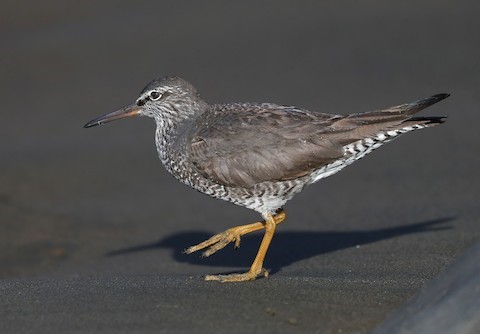
Wandering Tattler, breeding plumage, showing barred flanks and undertail coverts, diagnostic for Wandering. (Drakes Beach, Point Reyes, California; May 25, 2019.) © Matt Davis

Gray-tailed Tattler, breeding plumage—at the dark and heavily marked end of the spectrum, and thus easily confused with Wandering, but note the wide, long eyebrow and white streaks on the forehead. (Queens Esplanade, Thorneside, Redland, Queensland, Australia; April 3, 2020.) © Michael Daley
Juvenile Patterns: In fresh juvenile plumage, Wandering has whitish edges on the upperparts, giving it a scaly appearance, whereas juvenile Gray-tailed has a “toothed” pattern: dotted lines that consist of whitish spots separated by dark spots. These patterns can be distinct, and in such cases they appear to be reliable, but they fade with feather-wear and become unreliable.

Gray-tailed Tattler, juvenile showing prominent toothed or dotted-line pattern on upperparts. (Gambell, St. Lawrence Island, Alaska; September 3, 2019.) © Tammy McQuade
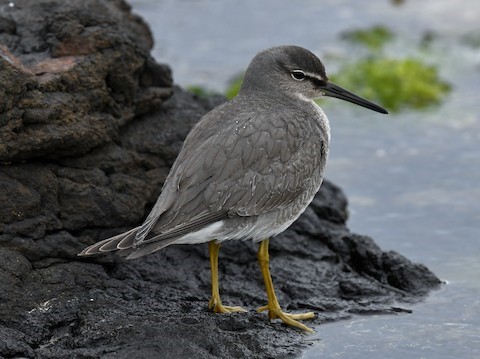
Wandering Tattler, juvenile showing faint scaled pattern on upperparts and flanks. (Flat Rock, Ballina, New South Wales, Australia; October 5, 2019.) © Steven McBride
Confusingly, some juvenile Wandering Tattlers show a toothed pattern—not as strong as a typical fresh juvenile Gray-tailed, but similar enough to be ambiguous. Adding to the potential confusion, some nonbreeding adult Gray-tailed have a slight scaled pattern—similar to juvenile Wandering.
The underparts also differ: juvenile Gray-tailed is white on the belly and flanks, whereas juvenile Wandering has more extensive gray, including the flanks—often with whitish edges, creating a scaled appearance, as on the upperparts.

Wandering Tattler, juvenile, appearing unusually pale—and showing a faint dotted-line pattern—but gray, faintly scaled flanks indicate Wandering, not Gray-tailed. (Barview, Oregon; September 24, 2019.) © Tanner Martin

Gray-tailed Tattler, juvenile, appearing unusually dark for a Gray-tailed, but showing prominent toothed or dotted-line pattern on upperparts and bold eyebrow. (Taiwan; October 11, 2020.) © Sin Syue Li
Tail Pattern: The name “Gray-tailed” is misleading, as both tattlers have gray tails. The difference is that adult Wandering’s tail is solid-gray, unmarked, whereas adult Gray-tailed has a subtle pale-scaled pattern on the uppertail coverts and rump. Unfortunately, this pattern is rarely discernible, and it appears to be useless for juveniles, as both species begin with a scaled appearance on the tail.

Wandering Tattler, juvenile showing plain, unmarked gray tail. (Flat Rock, Ballina, New South Wales, Australia; December 4, 2020.) © Steven McBride

Gray-tailed Tattler, nonbreeding plumage, showing very subtle scaled pattern on uppertail coverts. (Nairns, Mandurah, Western Australia; November 29, 2017.) © Geoffrey Groom
Academic Distinctions: A few of the differences often cited in references are unhelpful in field identification. Wandering averages about 5% larger than Gray-tailed in most measurements, but they overlap, so the potential size difference is both subtle and inconsistent. Their bills have a depression or groove that includes the nostril—the “nasal groove”—which reputedly exceeds half the bill length on Wandering, but not on Gray-tailed. However, some photographs of Wandering appear to have shorter grooves, so this supposedly absolute distinction may be misleading.

Gray-tailed Tattler, juvenile, close-up showing nasal groove ending near the mid-point of the bill. (Gambell, St. Lawrence Island, Alaska; September 3, 2019.) © Tammy McQuade
Notes
Monotypic species. The two tattlers, Wandering (incana) and Gray-tailed, were traditionally assigned to their own genus, Heteroscelus.
IUCN Red List Status: Near Threatened.
The Siberian Tattler. The name “Gray-tailed Tattler” is suboptimal. Both tattlers have gray tails, and Wandering’s tail is, if anything, grayer. It replaced the long-standing English name “Polynesian Tattler”, which was even less suitable, as both tattlers occur in Polynesia but Wandering is far more numerous and widespread in that region. A few authors, including Pratt et al. (1987) have adopted “Siberian Tattler”, which is accurate and denotes a valid distinction. Not widely adopted so far, but it would be an improvement.
References
Alderfer, J., and J.L. Dunn. 2014. National Geographic Complete Birds of North America (Second Edition). National Geographic Society, Washington, D.C.
BirdLife International. 2016. Tringa brevipes. The IUCN Red List of Threatened Species 2016: e.T22693289A93394897. https://dx.doi.org/10.2305/IUCN.UK.2016-3.RLTS.T22693289A93394897.en. (Accessed April 12, 2021.)
Brazil, M. 2009. Birds of East Asia. Princeton University Press.
eBird. 2021. eBird: An online database of bird distribution and abundance. Cornell Lab of Ornithology, Ithaca, N.Y. http://www.ebird.org. (Accessed April 13, 2021.)
Howell, S.N.G., I. Lewington, and W. Russell. 2014. Rare Birds of North America. Princeton University Press.
Marchant, J., T. Prater, and P. Hayman. 1986. Shorebirds: An Identification Guide to the Waders of the World. Houghton Mifflin, Boston.
Pratt, H.D., P.L. Bruner, and D.G. Berrett. 1987. A Field Guide to the Birds of Hawaii and the Tropical Pacific. Princeton University Press.
Pyle, R.L., and P. Pyle. 2017. The Birds of the Hawaiian Islands: Occurrence, History, Distribution, and Status. Version 2 (January 1, 2017). http://hbs.bishopmuseum.org/birds/rlp-monograph/. B.P. Bishop Museum, Honolulu, Hawaii.
Robson, C. 2002. Birds of Thailand. Princeton University Press.
Sibley, D.A. 2000. The Sibley Guide to Birds. Alfred A. Knopf. New York.
Xeno-Canto. 2021. Grey-tailed Tattler – Tringa brevipes. https://www.xeno-canto.org/species/Tringa-brevipes. (Accessed April 12, 2021.)

